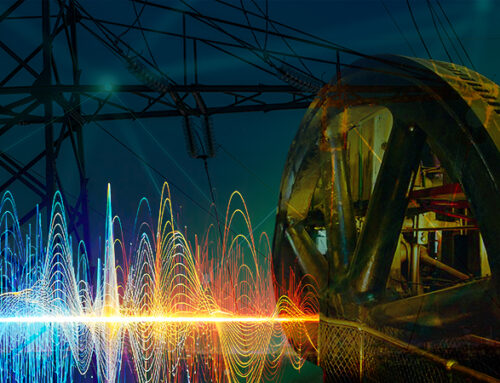Last week saw the news that National Grid has successfully trialled a method of measuring the inertia of the electricity system in real time. This may seem like a technical curiosity, but it has major implications for system management.
What is inertia……
Electrical inertia is the property of the system which opposes changes in current. In the power system, inertia is the term given to the store of kinetic energy found in by the rotating mass of traditional turbines which turn in synchronicity with each other and are coupled to the power system, delivering a steady system frequency.
In a 50 Hz system, thermal turbines all rotate at 3,000 RPM (nuclear turbines turn at half the rate), and the large mass of the turbines means that a significant amount of energy is required to alter the rate of rotation.

If supply and demand become imbalanced, the voltage of the system begins to fluctuate – when the demand exceeds supply, the system frequency will fall, and vice versa. The rate of change of frequency fall will depend on the initial power mismatch and level of system inertia.
The frequency fluctuations are resisted by the sources of inertia on the grid – the principle of conservation of energy requires that power in must equal power out at all times, so when there is a power imbalance on the system, energy is transferred between the kinetic energy stored in the rotating turbines and the power system in order to maintain equilibrium between generation and demand.
System inertia is expressed in GVAs (GVA seconds), which are equivalent to GJ. (Electrical power in watts is defined as the product of voltage and current (P = VI) per unit of time, and therefore the power rating of electrical equipment is often quoted in “MVA” which stands for Mega Volt Amps.)
The amount of the store of kinetic energy that can be used for managing frequency is restricted by the frequency limits being applied. For example, for a frequency deviation of ±0.5 Hz, only ±2% of the stored kinetic energy can be transferred before the frequency limit is exceeded. For a system with 200 GVA.s, this equates to 4 GVA.s (4 GJ) or approximately 4 seconds for an imbalance of 1 GW.
In order for a machine to contribute to system inertia, there has to be a direct electromagnetic coupling between the machine and the power system which allows disturbances on the system to be translated into a mechanical torque that acts on the machine rotor.
See the section below the line for a more detailed description of the interaction between generator turbines and system frequency.
……and why does it matter?
As more intermittent generation is connected to the electricity system, and traditional sources of inertia – primarily thermal generation – close, it becomes more difficult for system operators to manage grid frequency.
The replacement of thermal generation with renewables threatens this process in two ways: firstly renewable generation does not itself provide inertia, and secondly, as most renewable sources are intermittent, the constant variations in output make balancing supply and demand more difficult.
According to National Grid in its System Operability Framework 2016 paper:
“As system inertia drops due to the increasing proportion of non-synchronous generation, inertia becomes the major driver for frequency management requirements. Currently, system inertia can be no lower than 130 GVA.s postfault without de-loading nuclear generators or emergency instructions to disconnect inflexible generators.
This is due to the restriction on post-fault rate of change of frequency imposed by some loss of mains protection relays used by distributed generators. The pre-fault lowest inertia can be up to 8 GVA.s higher depending on the largest loss and how much inertia it contributes.
Provision of inertia at times of low transmission demand would currently require increasing intervention from the system operator to instruct conventional generators to run, even if they are out of economic merit.
The drop in inertia and increase in the largest generation or demand risk will require the development of new frequency response solutions. The design of new approaches in the medium and long term is likely to require a review of existing frequency response services.”

The inertia provided by synchronous generation is not always sufficient to maintain system frequency within acceptable operating levels, so National Grid procures various frequency response services from the market. These services are currently under review as the changing requirements of the system require new and different levels of response.
However, the costs of procuring these services is rising, so improving the efficiency of the procurement process through better system data could have significant benefits.
Measuring inertia
System operators generally estimate inertia by monitoring which transmission-connected generators are running, and adding an estimate of inertia from embedded generation and demand – this estimate is derived from analysis taken during a large frequency event in 2003 (the section below the line describes how the inertia of the GB power system was estimated from historic failure data). The ability to accurately measure inertia in real time would allow system operators to manage the grid and procure frequency response services in a more efficient manner.
The new system trialled by National Grid is known as GridMetrix, developed by Reactive Technologies. The project (known as Project SIM), explored whether the technology could measure the amount of inertia available on the grid in real time

The project was funded by Ofgem’s Network Innovation Allowance, and followed on from a previous project (Project Samuel) in which Reactive Technologies used its Grid Data Management System to transmit data though the electricity system by modulating the grid frequency. This could provide a broadcast system suitable for communicating with new demand-side response providers.
Historically inertia has been provided by thermal generators for free as a function of their synchronous grid connection, and as such, inertia has not been ascribed a value in the system. As the natural inertia of the grid falls, and frequency control becomes more difficult, new approaches need to be taken. As with most things, the first step in valuation is measurement, so with the ability to measure the available inertia on the grid at any point in time, system operators will be better placed to procure the most effective frequency support services.
National Grid is exploring a range of technologies – demand-side response and batteries already participate, but other approaches are also being considered including the use of large spinning turbines that would store rotational kinetic energy in the same way that thermal power station turbines do now, but without generating electricity. These devices, known as synchronous compensators may become one of the future tools for maintaining inertia…being able to accurately
Background to power system inertia
“From: “Use Of Smart Meters For Frequency And Voltage Control” – Kamalanath Bandara Samarakoon, PhD Thesis, Cardiff University, 2012
In an AC power system, the balance between generation and demand determines the frequency. If generation and demand are not in balance, for example due to a loss of generation, a sudden change of demand or a change of power output of renewable sources, the frequency may change rapidly.
Large frequency drops would damage transformers and induction motors due to the high magnetising currents required for maintaining the flux. These devices are widely used in transmission and distribution networks as well as in consumer appliances.
Turbine blades are designed to operate in a narrow band of frequencies to avoid mechanical vibrations of blades at their natural frequencies. Hence deviation beyond this band could damage the turbine.
When frequency drops, the air flow in generators and turbines will be reduced thus reducing cooling. Furthermore, the reduction in frequency causes generator control systems to increase their input power to maintain the generation and demand balance. The reduction in cooling and increase of power may result in an increase of the internal temperature of the turbine and generator windings. As the internal temperature increases, the protection devices will trip the generator thus increasing the imbalance between demand and generation.
The power output of coal plants depends on their motor driven auxiliary systems such as boiler feed water pumps, condensate pumps, coal pulverising and feeding equipment and draft fans. As system frequency decreases, these systems become less effective which further reduces the energy input to the turbine and the generator output. This reduction of generator output has a cascading effect on the power system where a loss of frequency leads to a loss of power which can cause frequency to drop further.
When frequency drops, generators increase their output by different amounts based on their droop characteristics. This could cause sudden changes in power flows across a power system. The changes in power flow may overload some transmission lines. As a result some lines could trip which might lead to system instability.
A stable frequency is required for some industry applications such as rolling mills, paper industries and processing lines that depend on the speed of motors. In these applications the speed of some processes is maintained by using synchronous motors. When the frequency drops, the process may be disturbed. This might lead to a substantial loss to the industry.
In the past, much equipment used the system frequency for synchronising their internal clock to a standard time. When frequency deviates from its normal value, the synchronised clocks also deviate from the standard time. At present, with the advent of stable crystal oscillators, precise stable time signals are available for digital equipment. However, it may be still required to use power system frequency to correct the drift of the oscillator that occurs over a period of time.
Therefore, in a power system, it is an obligation of the system operator to maintain frequency within tight limits and, if frequency deviates, to restore it to normal frequency within a specified time period. These frequency and time limits may be specified as statutory requirements.
Using Newton’s equation for rotating masses, the angular velocity of a turbine-generator unit (ωm) is:

The Inertia constant (H) of a generator-turbine unit is defined as the ratio of kinetic energy stored at the synchronous speed (ωsynm) to the generator kVA or MVA rating (SB).

The inertia constant of the current GB system was estimated using the low frequency incident that occurred on 27 May 2008. This incident was caused by the sudden loss of generators of 345 MW and 1,237 MW (the total system demand was 41,550 MW). These two generation losses were applied to the model and the inertia constant (H) was varied to fit the frequency variation to that of the real event shown in the chart below. It was found that an inertia constant of 9 s gives a good fit and that value was used in subsequent simulations.

In addition, with the introduction of power electronically coupled wind generators, Ekanayake1 has suggested that the system inertia constant might drop to as low as 3 s in 2020.
1 J. B. Ekanayake, N. Jenkins, and G. Strbac, “Frequency Response From Wind Turbines”, Wind Engineering, vol. 32, no. 6, pp. 573-586, 2008.






“MVA” which stands for Megawatt-Amps.
No. Mega VOLT Amps. VA or Volt Amps defines something slightly different from power since volts and amps may not be in phase in an AC system, and only the in phase components represent power.
“System inertia is expressed in GVAs (GVA seconds), which are equivalent to GJ.
No, GJ would be GW seconds. Again GVA is not strictly a power rating as ‘wattless amps’ can exist.
Apart from those nits, once again a very interesting article.
Summarised in another way, the only storage we have on the grid that is capable of reacting instantly a mismatch between generation and load is the rotating masses of the turbines and alternators. On a slightly increased time-scale, hydro – pumped or conventional – can be ramped up in a matter of seconds.
Once again the massive deficiencies caused by renewable inflexibility are highlighted.
Conventional power stations with stores of coal, gas or uranium, do not need storage to cover the dispatch to meet long term load following, and equipped with high mass rotating parts, they do not need external short term storage either.
Both of these need to be added to wind or solar, at a cost that is not borne by the renewable operator, but by the national grid, and hence the consumer.
Of course they could leave all the old coal plant generators in place and replace the steam plant with electric motors that would spin up the generators instead.
a ‘Legacy flywheel storage project’ 🙂
Hi Leo,
Many thanks for your comments and spotting my typo…too used to typing “watts”! I’ve corrected it above.
On the GVAs point….I took that directly from a National Grid paper, but it makes sense to me because I don’t think a source of inertia needs to be providing active power. However I could be wrong since I’m having to blow the dust off my physics knowledge for this!
I haven’t written it here, but my view is that the sensitivity of the grid to frequency is going to be a significant limiting factor to the deployment of renewables, but most people who talk about 100% renewables grids have no idea what it really means.
De-sensitising the entire grid might be possible in the very long term, but that’s essentially a fundamental re-design of the grid on the scale of the decision to switch from DC to AC in the very early days of electrification….ie nether quick nor cheap.
In the meantime, we have the prospect of caps on energy bills because no-one wants to pay for all this….
what’s the meaning of BMU
Balancing Mechanism Unit – BMUs are used as units of trade within the Balancing Mechanism. Each BM Unit accounts for a collection of plant and/or apparatus, and is considered the smallest grouping that can be independently controlled (see the Elexon website for more details)
How is the synchronous inertia measured in real-time?
Ron a few years have gone by since this article. You might be interested in how the ESO of GB describes it here
https://www.nationalgrideso.com/news/sonar-power-grid-new-inertia-measurement-tools-planned-great-britains-electricity-system
Typically in real time you can have systems calculating from high-sample-rate Phasor (of Volts & Amps) Monitoring Units [PMUs] as described in this paper.
https://eprints.whiterose.ac.uk/142996/1/Paper_H_Constant_v02.pdf
The inertia of a system is not the same everywhere none the less, and you can see disturbances propagate across the electrical grid rather like a wave going across the ocean. In fact, disturbances can cause protection issues at the opposite side of a grid from the area where the initial disturbance occurs. In GB a large interconnector trip in the SE of England can cause large swings in Volts and Frequency at the other end of the country. As a visual analogy imagine being a child back at a rock-pool on the shore. You heave a heavy rock into the deep end of the pool and watch the wave-front travel across the pool and into various branches and depths. The speed of travel and the wave height change with depth. Disturbances and the impact on local plant also have similar features in a power grid.
You can also measure power system inertia by injecting a known MW size disturbance (small enough to not trigger protection problems, but large enough that sensitive signal monitoring and processing can see the frequency ripples) can also calculate inertia at various places across the network. Injecting a drum beat can be used to keep inertia values calculated.
Would you say there is a convention on how much GW of conventional power plants online are equivalent to X amount of GVAs? If so, what is this conversion rate?